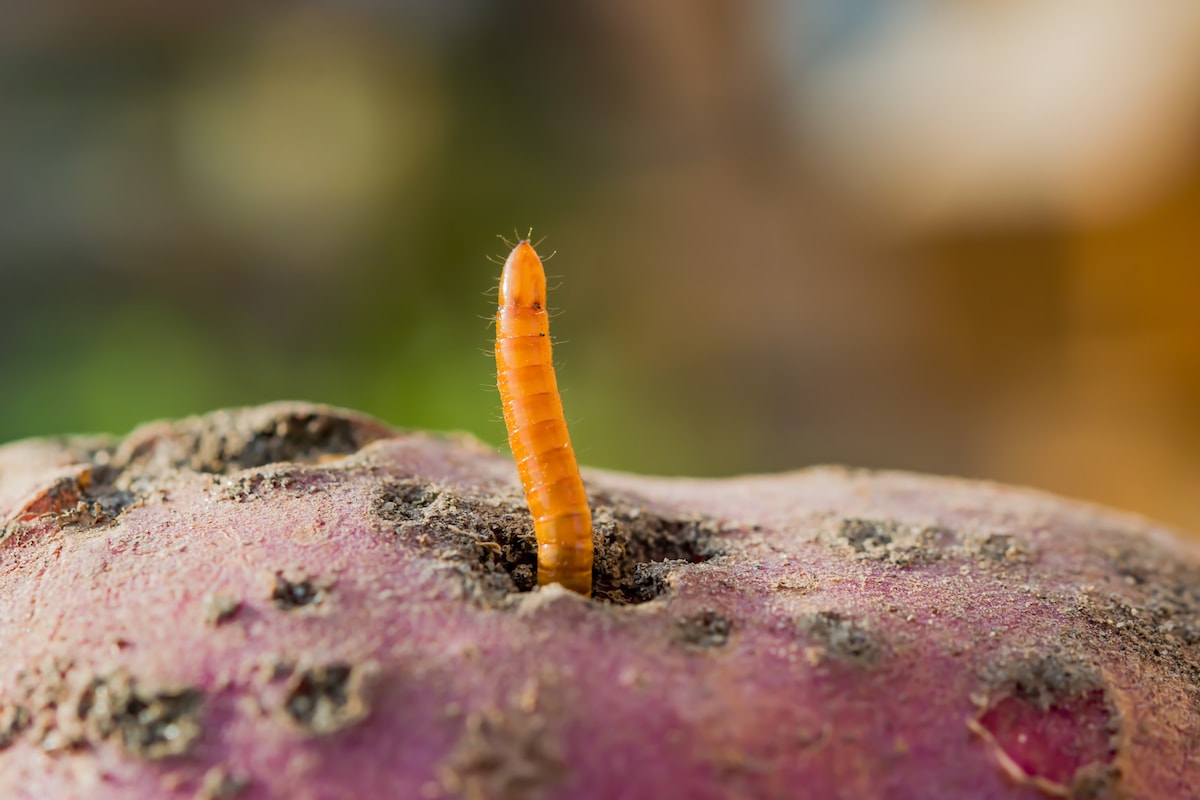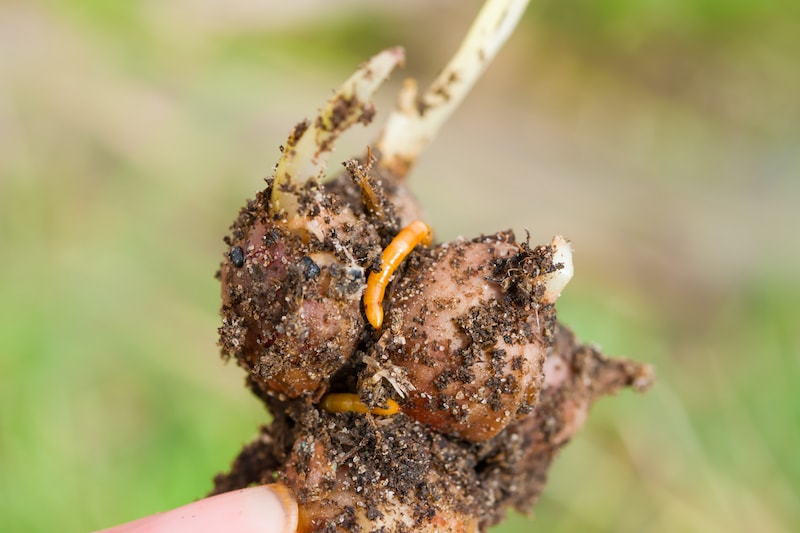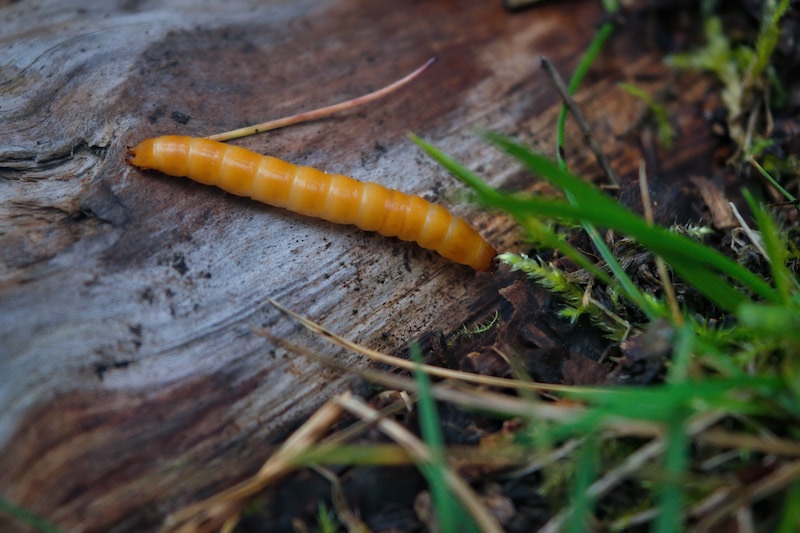One day everything is fine in your vegetable patch and the next your lettuce is suddenly hanging limp and sad? And that, although your green friend suffers no water shortage?
Then there is most likely the worm in it – in the truest sense of the word! The wireworm loves to eat your vegetables and does its nefarious work hidden under the ground.
But there are a few things you can do about it! How you can fight the wireworm with biological means, I show you in this article. Let’s go!

Contents
Is that the wireworm in my flower beds?
It is not so easy to catch the culprit wireworm in the act! It lives exclusively underground and works permanently undercover, so to speak. Wireworms love to tamper with the roots of your vegetables, such as corn or lettuce, or to cheekily bore their way into your potatoes.
Here’s how to spot them: Wireworms are two to three centimeters long and have a very hard yellowish-red chitinous shell – this shell also gave them their name! The wireworm head is brownish and in the front third it has three pairs of legs.
After pupation, a slender, light brown beetle hatches. Fortunately, the click beetle doesn’t give a damn about your vegetables – however, it lays eggs for new wireworm babies and then the whole mess starts all over again.
The life cycle of the wireworm is – as usual in nature – mainly designed for reproduction. It takes between three and five years for an egg to become a click beetle. This means that there are several generations of this pest living in your beds.
Each year, the beetles lay their eggs in the soil, and each year, wireworms hatch from them, which then feast on your vegetables until they pupate. That’s why it’s so important to control wireworms right away and not wait for them to completely take over your beds.
The female wireworms lay their eggs in the soil from mid-April to mid-June. They particularly like a soil that is as moist and dense as possible for this purpose.
The hatched wireworms are active mainly from early April to mid-May, from late June to mid-July and from mid-August to early October, eating everything in their path.

By the way, if you’re struggling with other pests in your vegetable beds, feel free to check out my articles on whitefly or aphids. 🙂
How does wireworm harm your vegetables?
If your vegetables suddenly hang their heads from one day to the next, this is not vegetable depression, but a real alarm sign that the wireworm is up to its mischief in your bed. It eats itself thick and round on all underground plant parts – regardless of losses – and eats delicious plant roots or even the tubers of your vegetables in no time at all.
Especially when there is little rain and the soil is dry, the wireworm bores into the plant parts under the ground to seek shelter and food. A clever little fellow! 😉
You can easily pull such a poor wireworm vegetable victim out of the ground. There are no roots left to hold your vegetables in the ground! But without roots, your green favorites can no longer absorb nutrients and water and dry up.
If you look closely, you can now see the holes and feeding tunnels of the culprit on the remaining underground plant parts or maybe even discover a living specimen. In the wounds of your plants, rot pathogens will then settle. This further weakens your plants and at the latest it becomes too much for it, so that it dies.
And the wireworm? It simply moves on to the next candidate completely unaffected!

Don’t welcome the wireworm in the first place: prevention is better than cure
To prevent the wireworm from spreading in your beds in the first place, here are a few tricks to make it clear that it is not welcome in your beds:
The wireworm is THE favorite dish for chickens, hedgehogs, toads, moles and birds – you just have to lure these hungry helpers into your garden:
Hedgehogs and toads you offer for it simply the free stay in a five-star hotel like a hedgehog house, piled up stones or a pile of leaves. By the way, these are also very nice design elements for the garden! Birds find nest boxes and a year-round food supply very enticing. They will then happily stay in your garden and help you control wireworm.
Grab the forks!
Compacted soil is a favorite habitat for wireworms. That’s why it’s best to consistently try to spoil their ideal conditions and loosen your soil with a (double) digging fork (external link) without turning it. This disturbance helps to drive the pesky co-inhabitant out of your beds and ensures that they no longer feel comfortable in the loose soil. Plus, both the eggs and the newly hatched wireworm babies dry out very easily if they continue to surface.
No longer a favorite food…
The wireworm especially loves vegetables like potatoes, carrots, corn, lettuce or beet. Therefore, you’d better not grow his favorite food in succession in the same place. He would then constantly have a richly laid table and could continue to multiply blithely.
So if you already had wireworms on your potatoes, it’s not a good idea to grow carrots or lettuce in that bed next.
Legumes like field beans and bush beans are a super precrop to make the soil unattractive to wireworm. Growing cruciferous crops like white cabbage is also a red flag for the wireworm. The mustard oils in cabbage ensure that the click beetle females look for another place for their nursery.
A good crop rotation helps immensely. In my article “Create crop rotation” I show you how you can easily plan an optimal crop rotation, so that nothing stands in the way of a fat vegetable harvest!
You are still looking for a cultivation plan in which everything is already figured out about mixed culture, crop rotation and cultivation breaks? Then download my sample vegetable garden plan! You can simply transfer it 1:1 to your beds and start gardening immediately!
Control the wireworm with biological means
If the wireworms have already moved into your beds and you want to get rid of them, you can build a wireworm trap:
To do this, cut several potatoes into wide slices and put them on skewers. Then you sink these baits five to ten centimeters deep into the soil between your plants and wait. The wireworm is totally into potatoes and bores into them to eat them up as quickly as possible. This is the moment when he has lost! 😉
Because after a few days you pull the skewers together with the hungry wolverines out of the ground and dispose of them in the organic waste garbage can. So you have already reduced the stock. Then you put new potato pieces on the skewers and bury them again. The other wireworms will now start eating the tasty food again, without even thinking for a second about where their buddies have gone. And bang – you have caught some again and removed them from your bed.
If you stick with it and have more stamina than your uninvited guests, you can keep the population down pretty well this way.
Marigolds and marigolds are toxic to wireworms, but luckily word hasn’t gotten out to them yet. So when they pounce on the plants in their gluttony, they get poisoned and die from it. So a good trick is to put these flowers among your vegetables. You’ll enjoy the beautiful sight and kill the wireworms along the way. Cool, right?
So you see, you don’t have to panic if the worm is in your vegetables. Then you are simply on the ball and the early bird that catches it. 😉 So you can keep damage within limits and still get a thick vegetable harvest!

